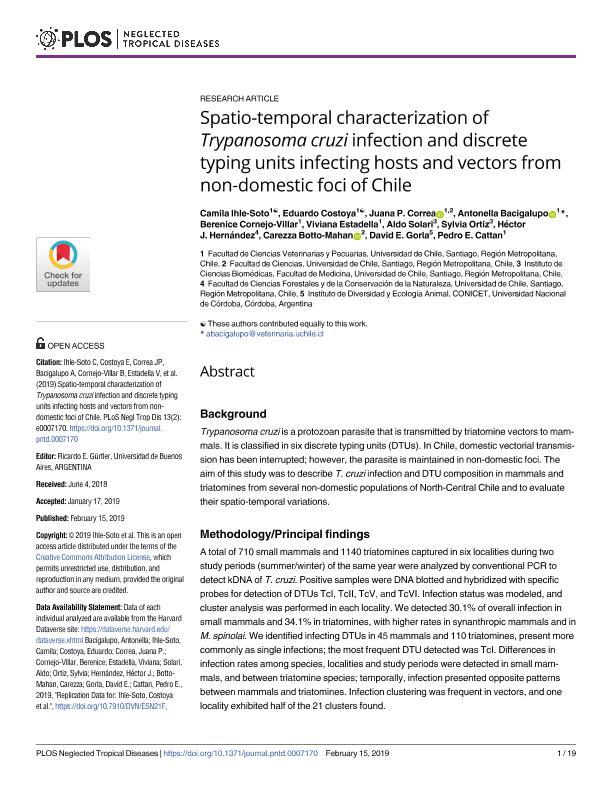Artículo
Spatio-temporal characterization of Trypanosoma cruzi infection and discrete typing units infecting hosts and vectors from non-domestic foci of Chile
Ihle-Soto, Camila; Costoya, Eduardo; Correa, Juana P.; Bacigalupo, Antonella; Cornejo-Villar, Berenice; Estadella, Viviana; Solari, Aldo; Ortiz, Sylvia; Hernández, Héctor J.; Botto-Mahanid, Carezza; Gorla, David Eladio ; Cattan, Pedro E.
; Cattan, Pedro E.
 ; Cattan, Pedro E.
; Cattan, Pedro E.
Fecha de publicación:
02/2019
Editorial:
Public Library of Science
Revista:
PLoS Neglected Tropical Diseases
ISSN:
1935-2727
e-ISSN:
1935-2735
Idioma:
Inglés
Tipo de recurso:
Artículo publicado
Clasificación temática:
Resumen
Trypanosoma cruziis a protozoan parasite that is transmitted by triatomine vectors to mam-mals. It is classifiedin six discrete typing units(DTUs).In Chile, domestic vectorial transmission has been interrupted; however, the parasite is maintained in non-domestic foci.The aim of this study was to describe T. cruzi infection and DTU composition in mammals and triatomines from several non-domestic populations of North-Central Chile and to evaluate their spatio-temporal variations. A total of 710 small mammals and 1140 triatomines captured in six localities during two study periods (summer/winter) of the same year were analyzed by conventional PCR to detect kDNA of T. cruzi. Positive samples were DNA blotted and hybridized with specific probes for detection of DTUs TcI, TcII, TcV, and TcVI. Infection status was modeled, and cluster analysis was performed in each locality. We detected 30.1% of overall infection in small mammals and 34.1% in triatomines, with higher rates in synanthropic mammals and in M. spinolai. We identified infecting DTUs in 45 mammals and 110 triatomines, present more commonly as single infections; the most frequent DTU detected was TcI. Differences in infection rates among species, localities and study periods were detected in small mammals, and between triatomine species; temporally, infection presented opposite patterns between mammals and triatomines. Infection clustering was frequent in vectors, and one locality exhibited half of the 21 clusters found. We determined T. cruzi infection in natural host and vector populations simultaneously in a spatially widespread manner during two study periods. All captured species presented T. cruzi infection, showing spatial and temporal variations. Trypanosoma cruzi distribution can be clustered in space and time. These clusters may represent different spatial and temporal risks of transmission.
Palabras clave:
TRYPANOSOMA CRUZI
,
CHAGAS DISEASE
,
TRIATOMINAE
,
CHILE
Archivos asociados
Licencia
Identificadores
Colecciones
Articulos(CCT - CORDOBA)
Articulos de CTRO.CIENTIFICO TECNOL.CONICET - CORDOBA
Articulos de CTRO.CIENTIFICO TECNOL.CONICET - CORDOBA
Citación
Ihle-Soto, Camila; Costoya, Eduardo; Correa, Juana P.; Bacigalupo, Antonella; Cornejo-Villar, Berenice; et al.; Spatio-temporal characterization of Trypanosoma cruzi infection and discrete typing units infecting hosts and vectors from non-domestic foci of Chile; Public Library of Science; PLoS Neglected Tropical Diseases; 13; 2; 2-2019
Compartir
Altmétricas



